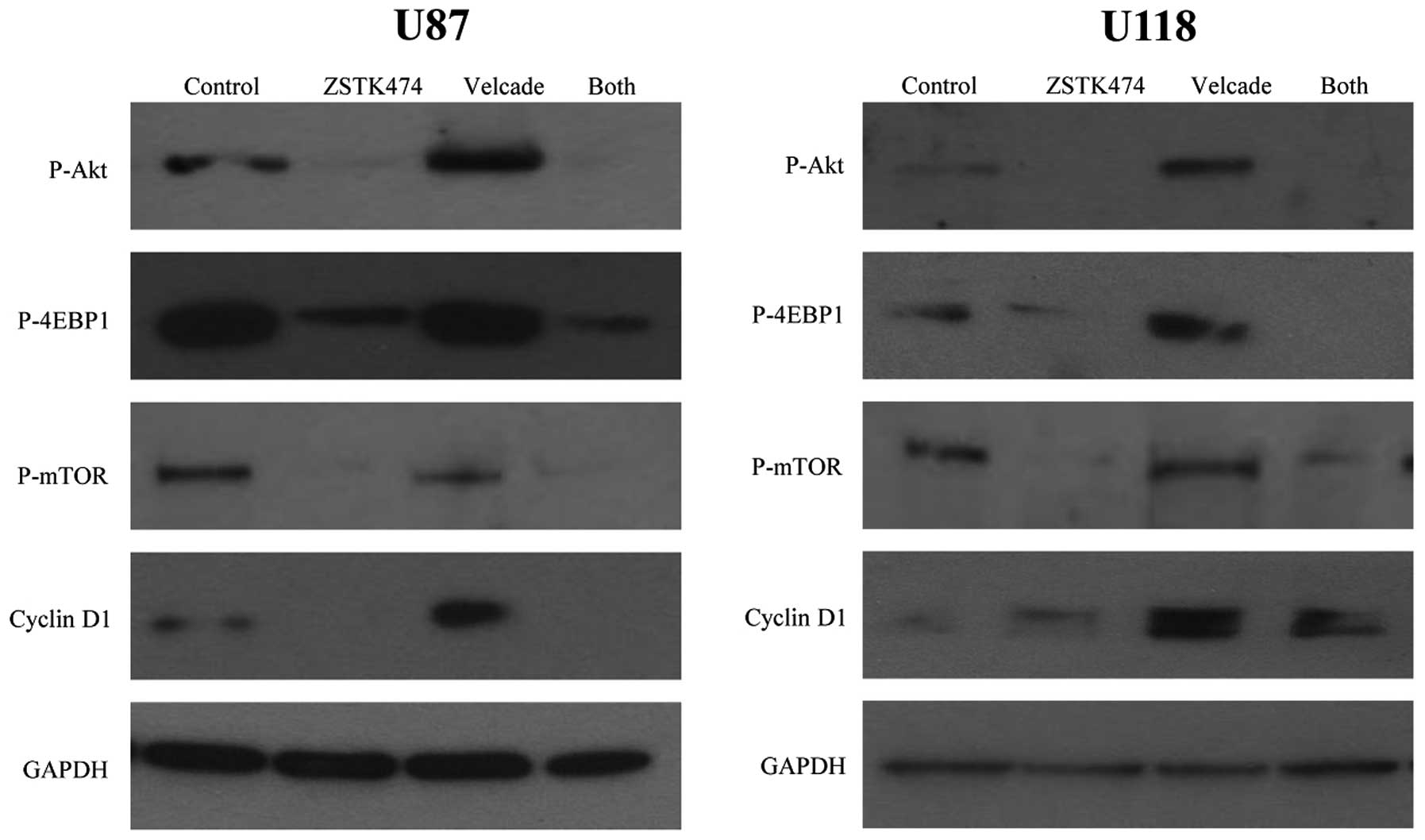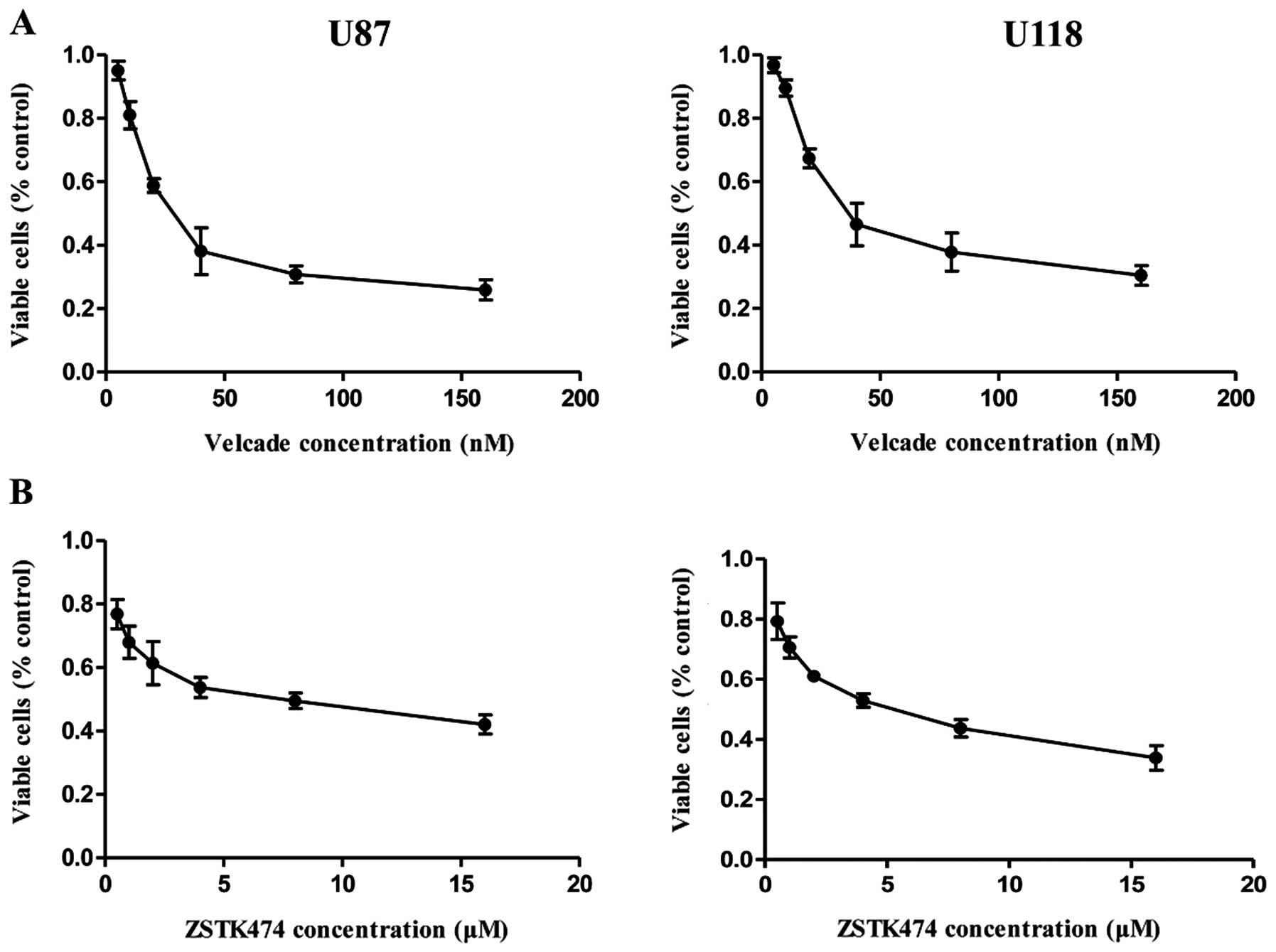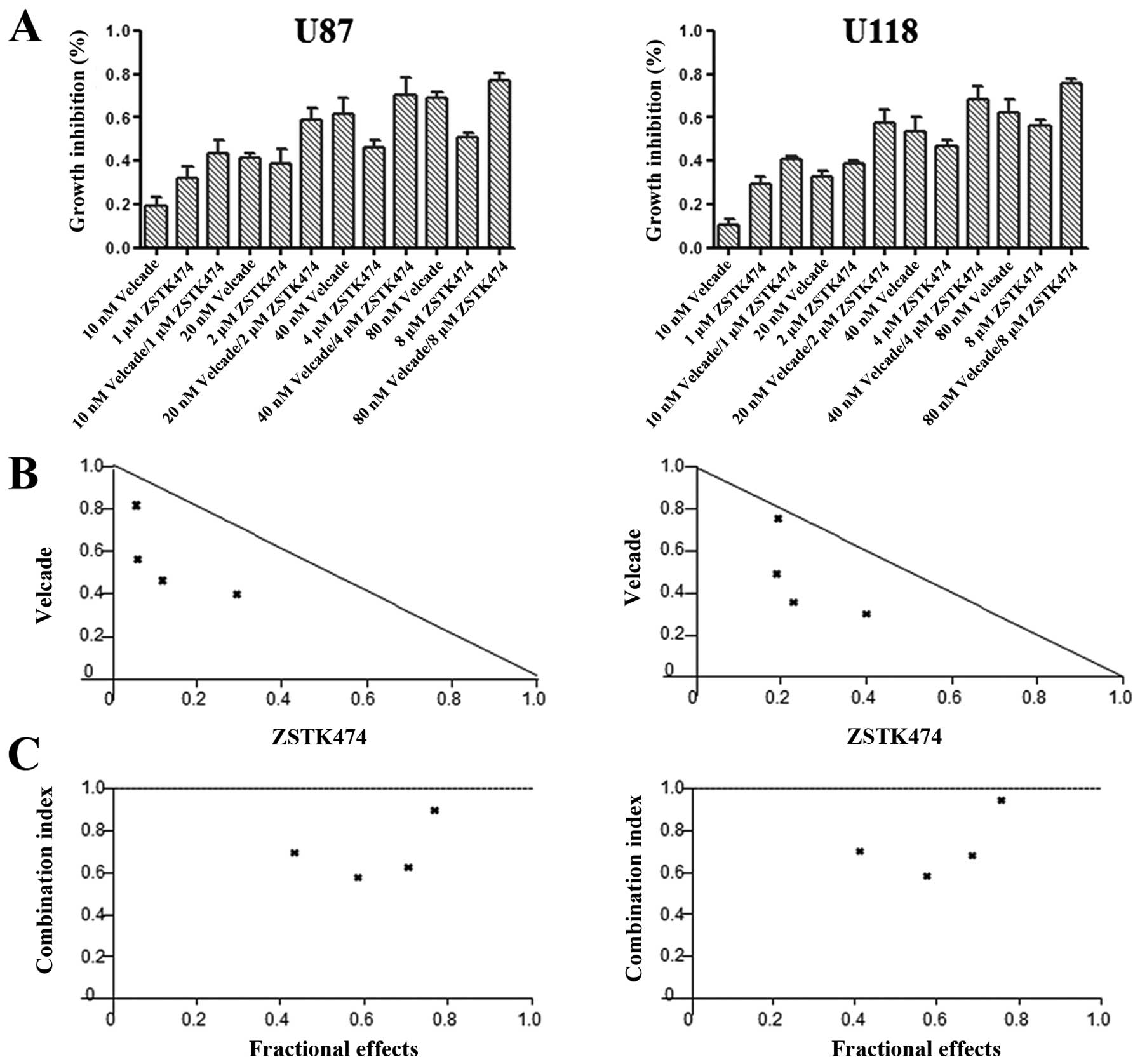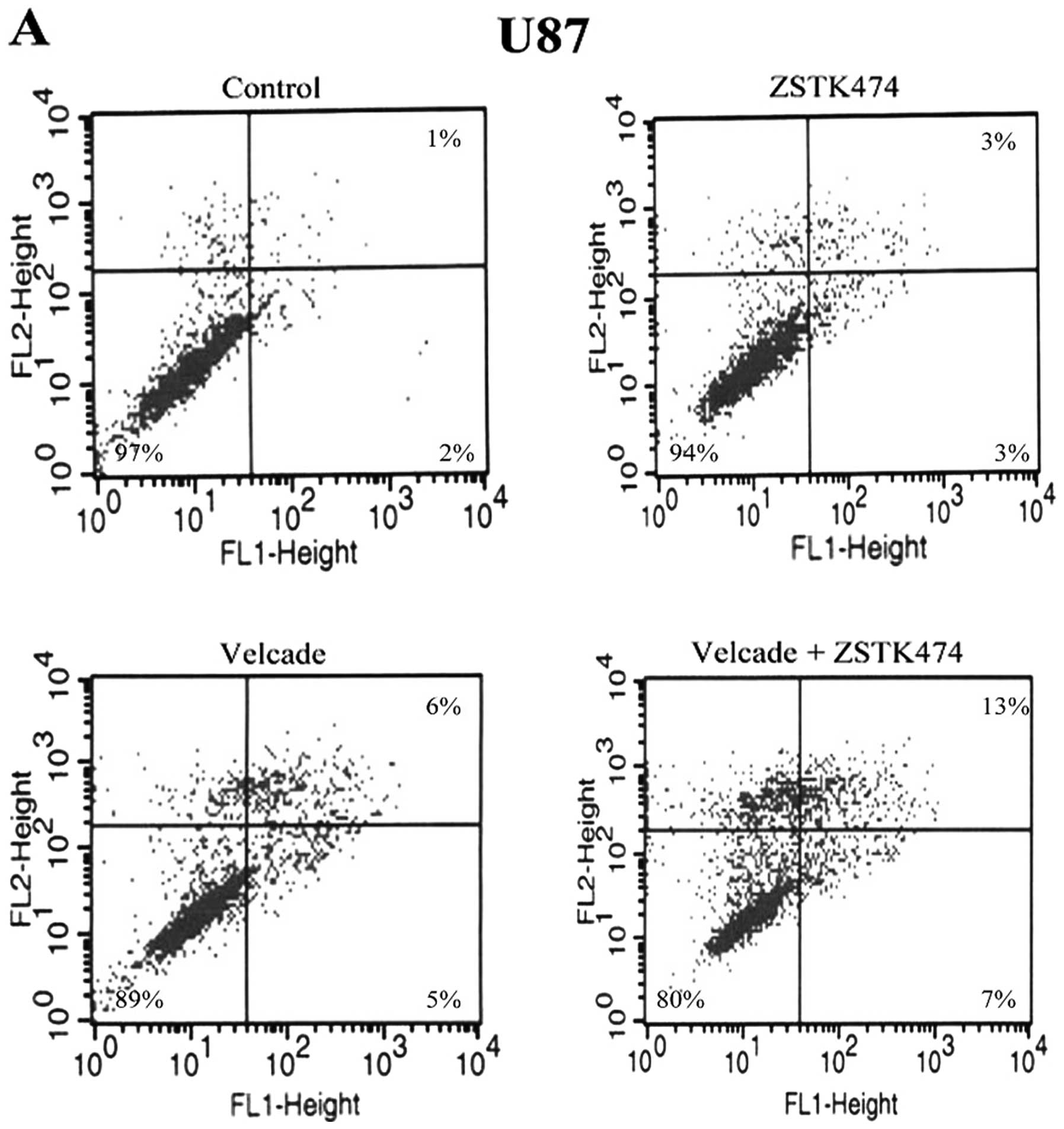Introduction
The ubiquitin-proteasome pathway is responsible for
degrading many of the short-lived regulatory proteins which govern
cell division, growth, activation, signaling and transcription
(1). Proteasome inhibition is a
novel approach to the treatment of solid tumors (2). Velcade (PS-341/bortezomib) is a
dipeptidyl boronic acid inhibitor with high specificity for the
proteasome and the first proteasome inhibitor evaluated in clinical
trials (1,3) and approved by the US Food and Drug
Administration (FDA). We previously found that Velcade had profound
effects on the growth and apoptosis of GBM cells (4). However, in this study, we found that
Velcade simultaneously caused an increase in P-Akt and left mTOR
signaling active in GBM cells.
Glioblastoma multiforme (GBM) is the most common
primary brain tumor in adults and known as having one of the worst
prognoses of all cancers. Successful treatment for GBM is rare. The
median survival for patients is 10–12 months, despite aggressive
surgical approaches, optimized radiation therapy regimens and
cytotoxic chemotherapies (5).
The PI3K/Akt pathway in GBM cells is highly active,
making it an ideal target for cancer therapy (5). Phosphatidylinositol 3-kinases (PI3Ks)
are a class of lipid kinases active in signal transduction that
generate phosphatidylinostiol-3,4,5-triphosphate (PIP3)
by phosphorylating phosphatidylinositol-4,5-bisphosphate (6). They are involved in various cellular
processes, including cell proliferation, adhesion, survival and
motility, all of which are critical for tumorigenesis (7). Mutation and/or amplification of PI3K
genes have been reported in many cancer cells, including
glioblastoma (7,8).
PI3Ks are activated by receptor tyrosine kinases
(RTKs). GBM cells commonly overexpress the oncogene epidermal
growth factor receptor (EGFR) and the platelet derived growth
factor receptor (PDGFR), both of which are the most common RTKs
(9). Downstream of these
receptors, the tumor suppressor gene PTEN, is also commonly
mutated, further promoting the activation of PI3K/AKT pathway
(5). Activation of PI3K pathway
members, such as P-PI3k, P-p7026k and P-Akt, has been
proven to significantly reduce overall survival times when gliomas
of all grades are considered (10). Many inhibitors of PI3K have been
extensively studied, such as wortmannin and LY294002. ZSTK474
[2-(2-difluoromethylbenzimidazol-1-y1)-4,6-dimorpholino-1,3,5-triazine]
is a novel PI3K inhibitor.
In the present study, the synergistic anti-glioma
activity of Velcade and ZSTK474 was examined using two GBM cell
lines. Treatment with both drugs inhibited proliferation and
increased apoptosis of GBM cells. Detrimental proteins for therapy,
such as P-Akt, P-4EBP1 and P-mTOR, were downregulated in the
presence of both drugs. Taken together, treatment with the
combination of Velcade and ZSTK474 was highly effective against GBM
and might have a role in the future therapy for this aggressive
disease.
Materials and methods
Glioma cell lines
Human GBM cell lines U87 and U118 were maintained in
Dulbecco’s modified Eagle’s medium (Gibco, BRL) with 10% fetal calf
serum (Gemini Bio-Products, Calabasas, CA, USA). Aliquots were
cryopreserved in liquid nitrogen, and one aliquot of cells was kept
in culture and grown to confluence. All cells were incubated at
37°C in 5% CO2.
Chemicals
Proteasome inhibitor Velcade, obtained from
Millennium Pharmaceuticals (Cambridge, MA, USA), was reconstituted
with normal saline USP/EP at a stock concentration of
10−4 M and stored at −20°C. PI3K inhibitor ZSTK474,
obtained from Selleckchem (Houston, TX, USA), was dissolved in DMSO
at a stock concentration of 5×10−3 M and stored at
−20°C. Fresh dilutions of media were made for each experiment.
Cell growth inhibition
Cells were placed into 96-well plates at
5.0×103 cells/well and respectively treated with single
agent alone or their combination for 72 h. Cell proliferation was
measured by MTT assay. Briefly, 20 μl MTT solution (5 mg/ml)
was added into each well for the last 4 h. Absorbance was measured
at 570 nm using a spectrophotometer (Roche Molecular Biochemicals,
Basel, Switzerland). Cell growth was determined in each group and
compared with that of the untreated cells.
Western blot analysis
Cells were harvested for total cell lysates with
RIPA buffer (1% Nonidet P-40, 0.5% sodium deoxycholate, 0.1% SDS,
50 mM Tris-HCl, pH 7.5) containing a mixture of protease inhibitors
(Roche Diagnostics GmbH, Mannheim, Germany) as well as 1 mM NaF and
1 mM NaVO4. Cell lysates were centrifuged at 12,000 rpm
for 20 min at 4°C. Supernatant was collected, and the protein
concentration was measured. The lysates (30 μg) were
denatured in the sample buffer (10% glycerol, 5% B-mercaptoethanol,
2.3% SDS, 62.5 mM Tris-HCl, pH 6.8) by boiling and then subjected
to 4–15% SDS-PAGE followed by electrotransfer to polyvinylidene
diflouride membrane. The immune complexes were visualized with
Supersignal West Pico Chemiluminescent Substrate or Supersignal
west dura extended duration substrate (Pierce, Rockford, IL, USA)
and normalized by internal control (GAPDH). Antibodies against
phosphorylated Akt (p-Akt), phosphorylated 4E-BP1 (p-4EBP1) and
phosphorylated mTOR (p-mTOR) were bought from Cell Signaling
Technology Inc. (MA, USA). Antibodies against cyclin D1, PARP and
GAPDH were obtained from Santa Cruz Biotechnology Inc. (Santa Cruz,
CA, USA).
Assessment of apoptosis
Annexin V assays (Annexin V-FITC Apoptosis Detection
kit; Pharmingen, San Diego, CA, USA) were performed according to
the manufacturer’s instructions. Briefly, cells were harvested
after exposure to drugs, washed twice with PBS, resuspended in 1X
binding buffer at a concentration of 1×106 cells/ml,
incubated with FITC-conjugated Annexin V and PI for 15 min and
measured by FACScan (Becton-Dickinson).
Results
Velcade activates the PI3K/Akt pathway in
GBM cells
The effectiveness of Velcade in causing growth
arrest and apoptosis in GBM cells has been proven (4), but interestingly, we found that
Velcade could stimulate the cell survival pathway PI3K/Akt
simultaneously. Using western blot analysis, we found that Velcade
could induce phosphorylation of Akt, 4E binding protein-1 (4EBP1)
and mammalian target of rapamycin (mTOR) in both GBM cell lines
compared to the control. As shown in Fig. 1, the amount of P-Akt was increased
in cells treated with Velcade compared to the control. Furthermore,
mTOR signaling was activated in the presence of Velcade as the
amount of P-4EBP1 and P-mTOR was comparable to the control.
Synergistic effects of Velcade and
ZSTK474 on GBM cell line
To study whether the inhibition of the PI3K/Akt
signaling pathway could enhance the Velcade-induced growth arrest
of GBM cells, we treated cells with both Velcade and the PI3K
inhibitor ZSTK474. When adding ZSTK474 (2.5 μM, 24 h), the
phosphorylation of Akt, 4EBP1 and mTOR was markedly decreased in
both cell lines (Fig. 1). Cyclin
D1, another protein central to cell proliferation in the PI3K/Akt
pathway, was also upregulated in the presence of Velcade alone but
downregulated when exposed in both drugs (Fig. 1).
We also examined the effects of Velcade and ZSTK474
on the proliferation of GBM cells in liquid culture using the MTT
(3-(4,5-dimethylthiazol-2-yl)-2,5-diphenyl tetrazolium bromide)
assay. Two cell lines were treated with serial dilutions of Velcade
or ZSTK474 alone for 72 h. Based on the growth inhibition assay,
IC50 of Velcade and ZSTK474 was calculated to be 40 nM
and 7 μM in U87 cells, and 54 nM and 5 μM in U118
cells (Fig. 2).
To evaluate the combined effects of Velcade and
ZSTK474, cell lines were individually exposed to both drugs at a
fixed ratio simultaneously for 72 h spanning the IC50 of
each drug. The synergistic cytotoxicity was demonstrated by MTT
assay (Fig. 3A), and the level of
synergy at each dose combination was further validated by isobole
analysis and CIs (Fig. 3B and C).
The CI values of combined treatment with 10 nM Velcade and 1
μM ZSTK474, 20 nM Velcade and 2 μM ZSTK474, 40 nM
Velcade and 4 μM ZSTK474, 80 nM Velcade and 8 μM
ZSTK474 were 0.696, 0.576, 0.628 and 0.894 in U87 cells, and 0.702,
0.585, 0.682 and 0.949 in U118 cells, respectively. All of these
values were well <1, suggesting high degree of synergism between
both drugs.
Velcade and ZSTK474 induces more
apoptosis on GBM cells than either drug alone
In order to investigate whether the synergistic
cytotoxicity was related to apoptosis, GBM cell lines were treated
with 100 nM Velcade and 2.5 μM ZSTK474 alone or their
combination simultaneously for 24 h, and stained with Annexin V/PI.
Apoptosis was determined by flow cytometry, including early
apoptotic cells (Annexin V-positive, PI-negative) and late
apoptotic cells (Annexin V- and PI-positive). The percentage of
apoptotic cells in the treatment of Velcade and ZSTK474 alone or
their combination was 11, 6 and 20% in U87 cells, and 6, 8 and 27%
in U118 cells (Fig. 4), indicating
that more apoptosis was caused in the presence of both drugs.
Immunoblotting analysis of the apoptotic-related
protein poly(ADP-ribose) polymerase (PARP) showed that the
C-terminal 85 kDa PARP apoptotic fragment was generated in each
cell line when treated with both Velcade and ZSTK474 (Fig. 5).
Discussion
Proteasome inhibitors are emerging as a promising
class of agents in the treatment of cancers (1,2). In
particular, the proteasome inhibitor Velcade (PS-341/bortezomib)
has been in clinical trials for many years for cancer patients with
advanced diseases, mostly multiple myeloma and mantle cell lymphoma
(3,11). Based on positive preclinical and
clinical studies, Velcade was approved by the US Food and Drug
Administration (FDA) for clinical use for multiple myeloma
treatment in 2008.
We have previously proven the effectiveness of
Velcade in causing growth arrest and apoptosis in GBM cells
(4). However, we recently
discovered that in GBM Velcade also activated the PI3K/Akt pathway,
which is known to increase tumorigenesis and is involved in cell
proliferation (12). Through
western blot analysis, we found that Velcade caused upregulation of
P-Akt and left the mTOR signaling still active (Fig. 1).
Thus, we assumed that blocking the PI3K/Akt pathway
might lead to the enhancement of the anticancer ability of Velcade.
In order to deactivate the PI3K/Akt pathway, we used the novel PI3K
inhibitor ZSTK474 in conjunction with Velcade. ZSTK474 has
previously been proven to suppress tumor growth in GBM (13,14).
With the presence of ZSTK474, P-Akt, P-4EBP1 and P-mTOR were
down-regulated. Cyclin D1 was also upregulated in the presence of
Velcade alone but downregulated with the combination of both drugs
(Fig. 1).
In order to prove the synergistic effects of Velcade
and ZSTK474, cell proliferation was examined by MTT assay. As the
CI values of each dose combination were <1 (Fig. 3C), synergism was observed between
the two drugs. Annexin V assays were also performed to study the
induction of cell apoptosis, and an increase in apoptosis was
observed in the presence of both drugs.
In conclusions, we demonstrated that Velcade and
ZSTK474 was a synergistic drug combination that had profound
effects on GBM cells. This was accompanied by increased apoptosis
and decreased activation of many proteins central to the PI3K/Akt
pathway. These findings suggested that combination treatment of
Velcade and ZSTK474 might have a niche in the future therapy for
glioblastomas.
Abbreviations:
|
GBM
|
glioblastoma multiforme
|
|
PI3K
|
phosphoinositide 3-kinase
|
|
PARP
|
poly(ADP-ribose) polymerase
|
|
MTT
|
3-(4,5-dimethylthiazol-2-yl)-2,5-diphenyl tetrazolium bromide
|
Acknowledgements
This study was supported by grants
from the Natural Science Foundation of China (81071788, 81272956);
grants from the ‘985 project’ of Sun Yat-sen University; grants
from the ‘Team project’ of Guangdong Provincial Department of
Science and Technology (S2012030006287); grants from Guangzhou
Bureau of Science and Information Technology (2013J4500011); grants
from the Key Laboratory of Guangdong Higher Education Institutes
(KLB09001) and Guangzhou Bureau of Science and Information
Technology ([2013]163); grants from the National Institutes of
Health 1U54CA143930-01 and 5R01CA026038-32, A*STAR
grant.
References
|
1.
|
Adams J, Palombella VJ and Elliott PJ:
Proteasome inhibition: a new strategy in cancer treatment. Invest
New Drugs. 18:109–121. 2000. View Article : Google Scholar : PubMed/NCBI
|
|
2.
|
Yamamura M, Hirai T and Yamaguchi Y:
Proteasome inhibitor. Nihon Rinsho. 68:1079–1084. 2010.(In
Japanese).
|
|
3.
|
Chen D, Frezza M, Schmitt S, Kanwar J and
Dou QP: Bortezomib as the first proteasome inhibitor anticancer
drug: current status and future perspectives. Curr Cancer Drug
Targets. 11:239–253. 2011. View Article : Google Scholar : PubMed/NCBI
|
|
4.
|
Yin D, Zhou H, Kumagai T, et al:
Proteasome inhibitor PS-341 causes cell growth arrest and apoptosis
in human glioblastoma multiforme (GBM). Oncogene. 24:344–354. 2005.
View Article : Google Scholar : PubMed/NCBI
|
|
5.
|
Mischel PS and Cloughesy TF: Targeted
molecular therapy of GBM. Brain Pathol. 13:52–61. 2003. View Article : Google Scholar : PubMed/NCBI
|
|
6.
|
Vivanco I and Sawyers CL: The
phosphatidylinositol 3-Kinase AKT pathway in human cancer. Nat Rev
Cancer. 2:489–501. 2002. View
Article : Google Scholar : PubMed/NCBI
|
|
7.
|
Samuels Y, Wang Z, Bardelli A, et al: High
frequency of mutations of the PIK3CA gene in human cancers.
Science. 304:5542004. View Article : Google Scholar : PubMed/NCBI
|
|
8.
|
Shayesteh L, Lu Y, Kuo WL, et al: PIK3CA
is implicated as an oncogene in ovarian cancer. Nat Genet.
21:99–102. 1999. View
Article : Google Scholar : PubMed/NCBI
|
|
9.
|
Krakstad C and Chekenya M: Survival
signalling and apoptosis resistance in glioblastomas: opportunities
for targeted therapeutics. Mol Cancer. 9:1352010. View Article : Google Scholar : PubMed/NCBI
|
|
10.
|
Chakravarti A, Zhai G, Suzuki Y, et al:
The prognostic significance of phosphatidylinositol 3-kinase
pathway activation in human gliomas. J Clin Oncol. 22:1926–1933.
2004. View Article : Google Scholar : PubMed/NCBI
|
|
11.
|
Ruggeri B, Miknyoczki S, Dorsey B and Hui
AM: The development and pharmacology of proteasome inhibitors for
the management and treatment of cancer. Adv Pharmacol. 57:91–135.
2009. View Article : Google Scholar : PubMed/NCBI
|
|
12.
|
Luo J, Manning BD and Cantley LC:
Targeting the PI3K-Akt pathway in human cancer: rationale and
promise. Cancer Cell. 4:257–262. 2003. View Article : Google Scholar : PubMed/NCBI
|
|
13.
|
Dan S, Yoshimi H, Okamura M, Mukai Y and
Yamori T: Inhibition of PI3K by ZSTK474 suppressed tumor growth not
via apoptosis but G0/G1 arrest. Biochem Biophys Res Commun.
379:104–109. 2009. View Article : Google Scholar : PubMed/NCBI
|
|
14.
|
Kong D and Yamori T: Advances in
development of phosphatidylinositol 3-kinase inhibitors. Curr Med
Chem. 16:2839–2854. 2009. View Article : Google Scholar : PubMed/NCBI
|



















